Locating the Computer Monitor
By Joy M. Ebben, Ph.D, CPE
Human Factors and Ergonomic Specialist, IAC, a Division of Treston, Brea, Calif.
Monitor placement is a misunderstood area of workstation configuration. The ANSI/ HFI 100-1998 standard requires positioning computer monitors to locate the display area 0-60° below the viewer’s eye level. Kroemer notes that reasons for locating the screen below eye level include visual accommodation and convergence.
Accommodation, used for focusing, changes the shape of the lens of the viewer’s eye for different viewing distances. For most people, reading is easiest when looking down, rather than when looking ahead or up. And as the target moves closer, the preferred line-ofsight direction becomes more downward.
Convergence is the physical rotation of the eyes inward, toward the nose, so that both eyes focus the image at the same location on their retinas. As in reading, most people find it easier to view an object placed below eye level rather than above.
For example, try to thread a fine needle. Typically, the task is easier when the needle is held below eye height. This is the reason behind the construction of bifocal eyeglasses. With the reading portion on the bottom of the lens, accommodation and convergence for reading are facilitated.
The optimum monitor location for both accommodation and convergence depends on the viewer’s visual capabilities, which change with age and visual correction. The optimum monitor location also depends on user preference. Hill and Kroemer report a wide range in preferred declination of the line-of-sight for sitting readers. Values between subjects varied about 65º for viewing distance of 0.5-1.0m. It should be noted that this discussion stresses declination of sight, not head tilt. According to Chaffin and Andersson forward head tilt should not exceed 20-30º for an extended time.
Other tasks the user is performing also affect monitor placement. For example, if a worker uses a microscope and then reads a monitor, the monitor should be located so as to reduce head and eye movement as well as changes in visual accommodation.
If viewing distances differ significantly between two targets, make adjustments to reduce fine focsing because of time require for proper accommodation. An example is reading standard text on a desk, and then looking up to read distant text such as a clock face or status board.
Depending on the size of the distant text, and the viewer’s age, the distant text may be difficult to read until the viewer’s eyes accommodate. If the distant text is larger than what would be used in changes in accommodation were not required, the viewer will be able to focus on and read the distant text more easily.
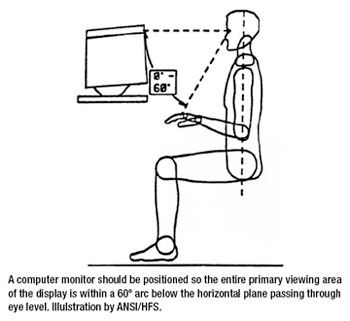 A general recommendation: Position the monitor screen slightly below eye level at a meter (39.37in.), or less, from the eyes of a person with normal eyesight. This assumes that the display can be acceptably read at the viewing distance. The screen should be lowered as it is moved closer. Workers should select the monitor’s height and viewing distance to meet their needs. Most likely this will require training in the principles of good viewing.
A general recommendation: Position the monitor screen slightly below eye level at a meter (39.37in.), or less, from the eyes of a person with normal eyesight. This assumes that the display can be acceptably read at the viewing distance. The screen should be lowered as it is moved closer. Workers should select the monitor’s height and viewing distance to meet their needs. Most likely this will require training in the principles of good viewing.
Additionally, a monitor should offer tilt and swivel adjustment, now commonly available. Tilt/ swivel options allow the user to optimize line-of-sight to the monitor for readability, and to compensate for les-than-ideal lighting. On-axis is best, and 40º is the maximum allowable off-axis angle.
Test various computer-monitor arms and platforms before purchase. Evaluate the vertical and horizontal clearances required to mount and use the platform with the intended monitor. Also, evaluate freedom from unwanted movement during use, ease of installation and repositioning, and overall size relative to monitor size. Other factors to consider are platform deflection under weight of the monitor, the range of motion relative to the size of the work surface and task requirements, pinch points or sharp edges, and compactness within a workstation.
 Buy Online Now!
Buy Online Now!
 Buy Online Now!
Buy Online Now!


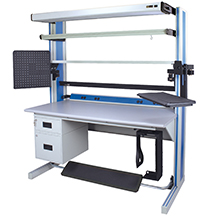
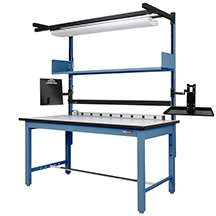
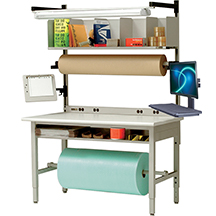
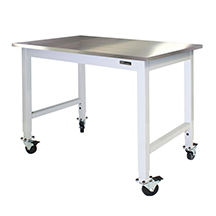





 A general recommendation: Position the monitor screen slightly below eye level at a meter (39.37in.), or less, from the eyes of a person with normal eyesight. This assumes that the display can be acceptably read at the viewing distance. The screen should be lowered as it is moved closer. Workers should select the monitor’s height and viewing distance to meet their needs. Most likely this will require training in the principles of good viewing.
A general recommendation: Position the monitor screen slightly below eye level at a meter (39.37in.), or less, from the eyes of a person with normal eyesight. This assumes that the display can be acceptably read at the viewing distance. The screen should be lowered as it is moved closer. Workers should select the monitor’s height and viewing distance to meet their needs. Most likely this will require training in the principles of good viewing.